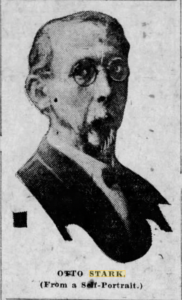
Photo info …
Credit: IndyStarView Source
(Jan. 29, 1859-Apr. 14, 1926). Born in Indianapolis, Stark received formal art training at age 16 as an apprentice to a lithographer in Cincinnati. He also enrolled as a night student at the School of Design of the University of Cincinnati.
Stark moved to New York City in 1879, and, for several years, he worked as an illustrator while studying at the Art Students’ League under the tutelage of , Walter Shirlaw, and Carroll Beckwith. Seeking more intensive training, he enrolled in the Académie Julian in Paris in 1885. There, he studied with Gustave Clarence Rodolphe Boulanger (1824-1888), then well-known as a classicist painter, and Jules-Joseph Lefebvre (1836-1911), best-known for his paintings of nudes in the classical style, as well as in the atelier of Fernand Cormon (1845-1924), a leading French painter of historical scenes at this time. Stark exhibited paintings in the Paris Salons of 1886 and 1887.
With his French wife, Marie Nitschelm, and their one-year-old daughter, Stark returned to New York City in 1888. He took a job in commercial art, supplementing his earnings with illustration work for and . After the family moved to Philadelphia in 1890, Marie, whose health had been weakened by successive childbirths, died in 1891. Stunned by her death, Stark took his four young children to Indianapolis, leaving them in the care of his father and sister while he pursued lithography in Cincinnati.
Two years later, Stark returned to Indianapolis where he taught classes in oil and watercolor from his studio on East Market Street. In 1899, he became the supervisor of art at and, in 1905, joined the faculty of the as an instructor of composition and illustration. As a teacher, Stark was known as much for his soft-spoken ways as for his technical competence in the classroom. Among the artists he influenced were , Marie Goth, , , and .
Despite Stark’s busy teaching schedule, he continued to produce exhibition pieces. While outdoor scenes dominated his work, Stark usually included figures in his compositions. Indeed, his focus was usually on the figure(s), rather than elements of the landscape. Of the , his work showed most clearly the impact of Impressionism.
Through the years, he participated in such exhibitions as the 1894 “Five Hoosier Painters” in Chicago, the 1898 Trans-Mississippi and International Exposition in Omaha, the 1904 Louisiana Purchase Exposition in St. Louis, the 1910 International Exhibition in Buenos Aires and Santiago, and the 1915 Panama-Pacific International Exposition in San Francisco. He also displayed his paintings in numerous regional exhibits.
Stark held his positions at Manual and John Herron until retiring from both in 1919. No longer bound by the academic calendar, he extended his yearly sketching trips with his colleague to Leland, Michigan, and New Smyrna, Florida. Stark continued to paint in his Indianapolis studio until the end of his life. His work is represented in the collections of the , the , and Manual High School.

Help improve this entry
Contribute information, offer corrections, suggest images.
You can also recommend new entries related to this topic.

